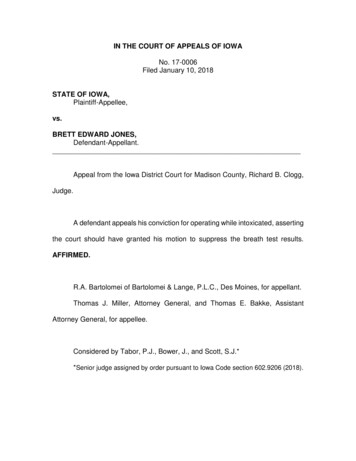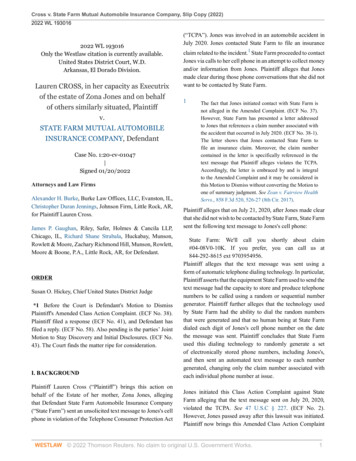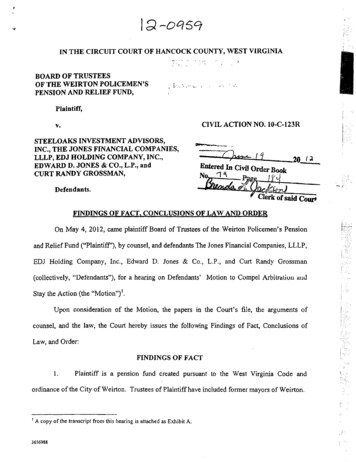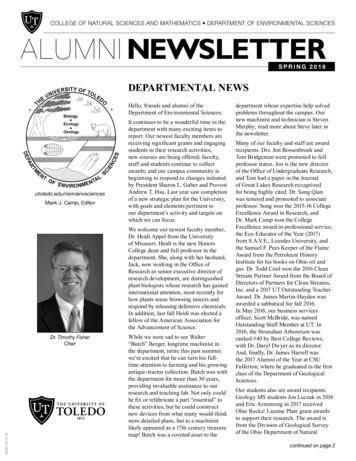
Transcription
AAUSTRALASIAdigitalwww.divelog.net.aud e og e auAUGUST 2022 No 395SPOTLIGHTSteve JonesMastering U/W PhotographyBrook PetersonSteve WrightMacroNirvanaSteve JonesSnappingSnaDragonsMike Scotland’sMarine Biology CourseNigel Marsh & Helen Rosefeatures Anemone fishFishes of Christmas Island
USING YOUR SMARTPHONE UNDERWATERIN A SEALIFE HOUSINGBy Nigel Marsh www.nigelmarshphotography.comPhotography has changed a great deal in the pasttwenty years with the digital revolution. Digital hasespecially made underwater photography so mucheasier than the days of film - with no limit of 36exposures, instant feedback and a great array ofcameras and housings to suit every budget. However, thegreatest change in digital photography in the last fewyears hasn’t come about due to better cameras or lenses,but by the invention of the smartphone.The smartphone has dramatically changed the way we takeimages and videos. Almost everyone has one in their pocket orhandbag, and if you want to take photos or videos of family andfriends most of us don’t grab a camera, we simply use ourphone. The rise of the smartphone has meant that compactcamera sales have plummeted.With a lack of sales, all camera manufacturers havedrastically cut back the production of compact cameras, and inthe case of Olympus, dropped out of the market altogether.Some have even speculated that in a few years there will be nocompact cameras available, with smartphones completelytaking over this end of the market.As most divers use compact cameras for their underwaterphotography this is going to have major implications in the nextfew years. You can of course use your current compact camerafor quite a few more years, but when it starts to age and needupdating you will have to replace it. But what are your options?If you want to stick with a camera your only option will be alarger and more expensive mirrorless camera and housingsystem (as DSLR cameras are also disappearing, but that isanother story). But what about if you could house yoursmartphone?The Sealife Sportdiver housing.But as I also teach underwater photography to dozens ofstudents each year, I started to do some research once I readabout the demise of the compact camera. It was then that Idiscovered that Sealife make a housing for smartphones calledthe Sportdiver.At first, I was a little sceptical, as I thought smartphones havesuch a limited range of functions and buttons, that controllingone through a housing would be very limited. And who wouldrisk losing all their phone contacts if you had a flood? Doing alittle more research I found that you control the phone with aspecial app and the housing has a vacuum seal, so has littlechance of flooding.A few years ago this suggestion would have been seen ascrazy, as there was no point spending money on a housing for asmartphone that didn’t have the performance quality of acompact camera. However, photography with a smartphone hasimproved significantly. They still have smaller sensors than acompact camera, but they produce good quality sharp images.Most also have several lenses, allowing you to shoot scenesfrom semi-wide angle to semi-macro. And besides the imagequality, most shoot 4K video and are weather-sealed, so arewaterproof, to a certain extent.I for one hadn’t even thought about housing a smartphone, asI still use my camera much more than my phone to take images.I didn’t think much more about a smartphone housing untiltalking to Tim Hochgrebe of Underwater.com, who import arange of underwater photography equipment. He informed methat the Sealife Sportdiver housing works very well and that hewould send me one to try out. A week later I had the Sportdiverhousing in my hands.So, what’s in the box? The Sportdiving housing comes in itsown padded carry case, with the housing, vacuum pump, spareo-rings, o-ring lubricant, a colour-correction red filter, differentsized rubber camera grips, an o-ring removal tool, a lanyard, amoisture pack, triple-AAA batteries, and instruction manual.Straight out of the box I was very impressed with the SealifeSportdiver housing. The housing is rated to 40m and made of atough solid polycarbonate, with an anodized lens frame andmarine grade stainless steel metal hardware. It also has onlyfive buttons to control the camera functions, and less buttonsmeans less potential flooding points. The back door latch iseasy to use, and locks when closed, and the baseplate hasthree threaded holes to connect a tray and arms. The housingweighs 680g and feels strong and sturdy in the hands.One great feature of this housing is that one model fits almostall smartphones, even my old five-year-old antique Samsung!So, if you update your smartphone you don’t need to buy a newhousing, as you do with a new camera model.The back of the Sealife Sportdiver housing.DIVE LOG Australasia August #395The inside of the housing is very simple with only one o-ring.The housing has a large window on the front for your camera’slenses, a battery compartment to power the moisture detectorand vacuum system, plus an on-off switch and a slot for a90www.divelog.net.au
Blacktip rockcod.Tawny nurse shark.moisture pack. There are also two small LED lights, one to tellyou the Bluetooth connection is working and the other formoisture detection and vacuum. As smartphones come in arange of different sizes there is a flexible holding spring on thetop of the housing and three different sized rubber cameragrips, that can be self-installed, depending on your phone size.I had a quick read through the manual, which is very easy tounderstand, and had the Sportdiver app downloaded in secondson my phone. The app takes control of the phone, leaving it oncontinuously so it doesn’t shutdown underwater. Installing thephone was very easy, and I found it connected to the housingvia Bluetooth instantly. The phone then came up with a pressuregauge, telling me it was time to try the vacuum pump. This tookonly three pumps, the phone then ran a three and half minutevacuum test, finally the green LED light informed me all is goodto go. That simple.Connected via Bluetooth, the housing doesn’t need anybuttons to align with the phone. Once it is ready to go the phonedisplays four icons on the left (photo, video, settings andpreview/playback) and five on the right (phone power, housingpower, video mode, zoom and Bluetooth). These are controlledby the four buttons on the back of the housing – mode, uparrow, down-arrow and OK.I had a quick play and found the buttons easy to use andcamera settings easy to navigate. In the settings I was verysurprised by the amount of control the system gives you. Ithought it would use only auto setting, like some of the morebasic compact cameras. And yes, you can simply use autoeverything and let the phone do the work. However, the appgives you some manual settings as well, allowing you to setshutter speed, ISO, exposure, white balance, photo resolution,video resolution and a few other things. The shutter releaseworks smoothly and is used for both photos and video.Sponge and tubastra coral.Red emperor snapper.Highfin rockcod.DIVE LOG Australasia August #39591www.divelog.net.au
Bearded scorpionfish.Whitespotted wedgefish.The only thing the Sportdiver app doesn’t allow you to use isthe phone’s flash. This was not an issue, as for my test dive Iwas planning to use a video light for photos and video (Sealifealso make the Sea Dragon photo-video light to compliment thishousing). This is a smart move by Sealife, as it forces you touse an external light source, meaning less chance ofbackscatter and better images.not the housing. The smartphone taking too long to focus, notfocusing well on macro subjects or focusing on the wrongsubject. As the phone doesn’t show you a focus point with asquare, like cameras do, it was hard to tell where it wasfocusing. After downloading the images, I found around 20%were out of focus. Some of these focusing issues were mostlikely my fault as I did pick some tricky focusing situations andprobably took a few images before the phone had time to focus.I am sure my success rate would improve with more practiseand getting more familiar with the phone.For my test dive I joined Scuba World for a double dive onHMAS Brisbane, off Mooloolaba, Queensland. Usually, I setupmy underwater housing the day before a dive trip, but becauseyou can’t turn the phone on or off once it is in the housing I did itthe morning of the dive to save battery power. Fortunately, thisonly took five minutes. For the test dive I also used a moremodern smartphone, the Huawei Mate20 Pro, borrowed from afriend (thanks Dave).Once underwater I quickly had the housing and smartphonerunning through its paces. I settled on the ships bow for the firstfew minutes, snapping off images of the more stationary reeffish. With these subjects it performed well. The zoom functionworked smoothly, using the up and down arrows, and switchingbetween photo and video mode was also simple.It was also easy to get near perfect exposure, as the phonedisplay shows you exactly what you get as you adjust theshutter speed, getting darker or lighter depending on thesetting. It would be nice to be able to control the f-stop, but onthis smartphone, like most models, it was fixed at f1.8. The onlyissue I had with the function buttons was that I found the displaya little small and hard to read, as I need reading glasses.I photographed a good range of subjects – a giant frogfish,angelfish, lionfish, hawkfish, scorpionfish, octopus and even awhite-spotted wedgefish and a tawny nurse shark. These lasttwo subjects, being over 2m long, were a little too big for thelens on this smartphone, but I still managed some good images.As mentioned, the phone didn’t do well with macro subjects,and with big animals and small critters being some of the mostphotogenic subjects that divers take images of having wideangle and macro capabilities is very important. I would be nice ifSealife were to produce wet lens for this housing, to allow formacro and wide-angle subjects. But I’m not sure if they could fitwet lens on this current housing model and also how they wouldalign these lenses with the phone lens being in differentlocations.Even with these minor faults I was very impressed by theimages the housing and phone produced.Testing the smartphone on moving fish proved to be a littleharder, as the slight shutter delay saw me mistiming a fewimages. Most of the issues I found came from the smartphone,The only real problem I found with the Sealife housing was itbeing a little clunky in my large hands. Holding it with my righthand to operate the shutter release, I found quite a few timesthat my palm accidently pushed the buttons on the back of thehousing, so changing the zoom and mode when I didn’t want itGiant frogfishBlue angelfish.DIVE LOG Australasia August #39592www.divelog.net.au
Blue-barred parrotfish.too. This could be solved by setting up an arm on this side ofthe housing for a hand grip. During my hour long dive the appshowed the battery power of the phone had dropped 20%,which was not bad considering I had it running the entire diveand shot over 170 images and six videos. I suspect you couldprobably get three or four dives out of this setup, depending onthe battery life of your smartphone.For this test dive I was very interested to discover that thephone worked without a SIM card. I simply connected thephone to my wifi at home to download the Sportdiver app. So, ifyou are concerned about flooding the housing and losing allyour phone data, simply remove the SIM card when you take itfor a dive. But hopefully with the vacuum system there is littlechance of a leak.Day octopus.Overall, I was very impressed by the Sealife SportdiverSmartphone Housing and think it is a good option for thoseThe Sealife Sportdiver Smartphone Underwater Housing isavailable from Underwater.com at only 489.DIVE LOG Australasia August #395wanting to take underwater images at a budget price. And withsmartphones getting better with each new release, the SealifeSportdiver Smartphone Housing has a big future ahead of it andI can see it being used by many divers that want a simple andeasy to use underwater photography system.93www.divelog.net.au
everything and let the phone do the work. However, the app gives you some manual settings as well, allowing you to set shutter speed, ISO, exposure, white balance, photo resolution, video resolution and a few other things. The shutter release works smoothly and is used for both photos and video. Blacktip rockcod. Tawny nurse shark. Red emperor .











